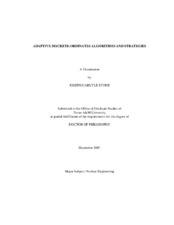| dc.contributor.advisor | Adams, Marvin | |
| dc.creator | Stone, Joseph Carlyle | |
| dc.date.accessioned | 2010-01-15T00:04:36Z | |
| dc.date.accessioned | 2010-01-16T00:23:32Z | |
| dc.date.available | 2010-01-15T00:04:36Z | |
| dc.date.available | 2010-01-16T00:23:32Z | |
| dc.date.created | 2007-12 | |
| dc.date.issued | 2009-05-15 | |
| dc.identifier.uri | https://hdl.handle.net/1969.1/ETD-TAMU-2093 | |
| dc.description.abstract | The approaches for discretizing the direction variable in particle transport
calculations are the discrete-ordinates method and function-expansion methods. Both
approaches are limited if the transport solution is not smooth.
Angular discretization errors in the discrete-ordinates method arise from the inability
of a given quadrature set to accurately perform the needed integrals over the direction
("angular") domain. We propose that an adaptive discrete-ordinate algorithm will be
useful in many problems of practical interest. We start with a "base quadrature set" and
add quadrature points as needed in order to resolve the angular flux function. We
compare an interpolated angular-flux value against a calculated value. If the values are
within a user specified tolerance, the point is not added; otherwise it is. Upon the
addition of a point we must recalculate weights.
Our interpolatory functions map angular-flux values at the quadrature directions to a
continuous function that can be evaluated at any direction. We force our quadrature
weights to be consistent with these functions in the sense that the quadrature integral of
the angular flux is the exact integral of the interpolatory function (a finite-element methodology that determines coefficients by collocation instead of the usual weightedresidual
procedure).
We demonstrate our approach in two-dimensional Cartesian geometry, focusing on
the azimuthal direction The interpolative methods we test are simple linear, linear in
sine and cosine, an Abu-Shumays “base” quadrature with a simple linear adaptive and an
Abu-Shumays “base” quadrature with a linear in sine and cosine adaptive. In the latter
two methods the local refinement does not reduce the ability of the base set to integrate
high-order spherical harmonics (important in problems with highly anisotropic
scattering).
We utilize a variety of one-group test problems to demonstrate that in all cases,
angular discretization errors (including "ray effects") can be eliminated to whatever
tolerance the user requests. We further demonstrate through detailed quantitative
analysis that local refinement does indeed produce a more efficient placement of
unknowns.
We conclude that this work introduces a very promising approach to a long-standing
problem in deterministic transport, and we believe it will lead to fruitful avenues of
further investigation. | en |
| dc.format.medium | electronic | en |
| dc.format.mimetype | application/pdf | |
| dc.language.iso | en_US | |
| dc.subject | Adaptive | en |
| dc.subject | Discrete-Ordinates | en |
| dc.subject | Particle | en |
| dc.subject | Transport | en |
| dc.subject | quadrature | en |
| dc.subject | azimuthal | en |
| dc.subject | discretization | en |
| dc.subject | ray-effects | en |
| dc.title | Adaptive discrete-ordinates algorithms and strategies | en |
| dc.type | Book | en |
| dc.type | Thesis | en |
| thesis.degree.department | Nuclear Engineering | en |
| thesis.degree.discipline | Nuclear Engineering | en |
| thesis.degree.grantor | Texas A&M University | en |
| thesis.degree.name | Doctor of Philosophy | en |
| thesis.degree.level | Doctoral | en |
| dc.contributor.committeeMember | Lazarov, Raytcho | |
| dc.contributor.committeeMember | Morrel, Jim | |
| dc.contributor.committeeMember | Nelson, Paul | |
| dc.contributor.committeeMember | Ragusa, Jean | |
| dc.type.genre | Electronic Dissertation | en |
| dc.type.material | text | en |
| dc.format.digitalOrigin | born digital | en |


